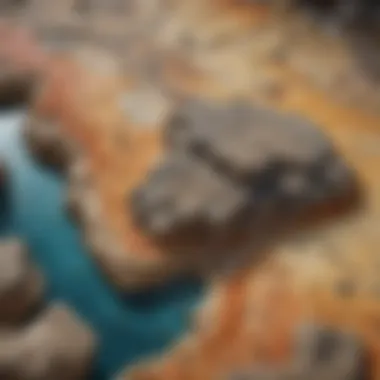Unveiling the Enigmatic World of Rock Identification: An In-Depth Guide for Stone Enthusiasts


Description of the Article
Unlocking the mysteries of rock identification has never been easier with this comprehensive guide for enthusiasts. Learn basic to advanced techniques, and gain the knowledge and tools needed to appreciate and categorize geological treasures!
Rock and Fossil Identification
Exploring the fascinating realm of rock and fossil identification offers a gateway to understanding Earth's geological history. Rock enthusiasts delve into various types, ranging from sedimentary to metamorphic, each unveiling unique characteristics waiting to be deciphered. The identification journey is enriched by observing key features such as color, texture, and structure, which serve as distinct markers aiding in classification.
To enhance the exploration process, the utilization of specialized tools elevates precision and accuracy. From magnifying loupes to Mohs hardness scales, these tools equip enthusiasts with the means to conduct intricate examinations that unravel the secrets held within each stone. By honing observation skills and tapping into scientific instruments, collectors embark on a meticulous journey of discovery and discernment.
Collecting Tips and Techniques
Excelling in the art of collecting rocks and fossils demands a blend of precision and patience. With a focus on best practices, enthusiasts navigate prime collecting sites brimming with geological wonders. By honing the ability to spot geological hotspots and employing strategic extraction methods, collectors unearth specimens with care and reverence.
The process of safely extracting specimens adds another layer of expertise to the collector's skill set. Employing delicate techniques to preserve the integrity of each find, enthusiasts ensure that these treasures retain their beauty and scientific value. By combining knowledge with dexterity, collectors create a harmonious balance between exploration and conservation.
Preservation and Display
Preserving rocks and fossils safeguards their natural splendor for future generations to appreciate. Embracing techniques that encompass cleaning, stabilizing, and protecting these geological artifacts ensures longevity and beauty. By employing proper storage methods that shield specimens from environmental factors, collectors maintain the integrity of their collections.
In considering creative display ideas, enthusiasts showcase their treasures in innovative ways that highlight the inherent allure of each rock or fossil. From elegant shelving arrangements to illuminated exhibits, the presentation of geological specimens transforms into an artistic narrative that captivates onlookers. Embracing creativity alongside geological appreciation turns preservation and display into a harmonious symphony of art and science.
Geological Insights
Delving into geological insights provides a deeper understanding of Earth's evolution and the forces shaping its landscapes. Exploring the significance of geological formations and processes unveils the intricate mechanisms that have sculpted our planet over millennia. Unraveling the historical context of rocks and fossils sheds light on past climates, flora, and fauna, offering a glimpse into ancient ecosystems.
The historical significance of notable discoveries within the field of geology showcases humanity's enduring curiosity and quest for knowledge. From groundbreaking fossil finds to geological phenomena that rewrite the narrative of Earth's history, these discoveries underscore the relentless pursuit of unraveling the mysteries embedded within geological treasures.
Introduction to Rock Identification
Rock identification serves as the foundation for enthusiasts to appreciate and categorize geological treasures comprehensively. This article delves into various aspects of rock identification, from basic characteristics to advanced techniques, providing valuable insights for both novices and seasoned collectors in navigating the intricate world of rocks with confidence and expertise.
What is Rock Identification?
The Significance of Identifying Rocks
Identifying rocks is crucial in understanding the Earth's history and geological processes. It enables enthusiasts to unravel the origins of different rocks, their formation conditions, and geological significance. Through rock identification, collectors can decipher the story behind each stone, fostering a deeper connection with the planet's diverse geological heritage. This section sheds light on why identifying rocks is pivotal for enthusiasts seeking to delve into the mysteries of Earth's geological past.
Tools and Methods Used in Rock Identification
Rock identification employs various tools and methods, ranging from basic observational techniques to advanced laboratory analyses. These tools include magnifying lenses, streak plates, and hardness tests, while methods include petrographic microscopy, X-ray diffraction analysis, and chemical analyses. Each tool and method offers distinct advantages in enhancing the accuracy and precision of rock identification, underscoring their indispensable role in streamlining the classification process for enthusiasts.
Understanding Rock Formation


Igneous Rocks
Igneous rocks originate from the cooling and solidification of magma or lava. Their formation provides insights into Earth's volcanic activities, offering clues about the composition and temperature conditions below the surface. By understanding igneous rocks, collectors can grasp the violent yet fascinating processes that shape the planet's crust, forming an integral part of Earth's geological tapestry.
Sedimentary Rocks
Sedimentary rocks form through the deposition and consolidation of mineral and organic particles over time. These rocks unveil clues about past environments, climate conditions, and even ancient life forms. By exploring sedimentary rocks, enthusiasts embark on a journey through Earth's history, unraveling tales of past landscapes and ecosystems with each distinct sedimentary layer.
Metamorphic Rocks
Metamorphic rocks undergo profound changes in mineralogy and texture due to high pressure and temperature conditions. Their formation reflects the dynamic nature of Earth's crust, showcasing the transformative forces at play beneath the surface. Acknowledging metamorphic rocks empowers collectors to appreciate the resilience and adaptability of rocks in response to intense geological forces, adding a layer of complexity to their rock identification journey.
Basic Characteristics to Look For
Color and Texture
Color and texture are fundamental traits in rock identification, offering initial insights into a rock's composition and history. The variation in color may indicate different mineral contents, while texture reveals the rock's formation conditions, such as rapid cooling or slow crystallization. By examining color and texture, enthusiasts can form preliminary hypotheses about a rock's origin and classification, laying the groundwork for more in-depth analysis.
Grain Size and Shape
Grain size and shape provide additional clues about a rock's formation and history. The size of grains indicates the cooling rate of molten rock, with larger grains suggesting slow cooling, whereas shapes may hint at the rock's deformation history. Understanding grain characteristics aids collectors in discerning between various rock types and deducing the environmental conditions under which the rock formed, enriching their identification process.
Mineral Composition
Mineral composition serves as a defining feature in rock identification, as different minerals exhibit distinct properties and crystal structures. Analyzing the mineral content of a rock enables collectors to classify it into specific categories, unveiling its parent rock type and geological context. By scrutinizing mineral composition, enthusiasts can unravel the intricate details of a rock's identity, unlocking a wealth of information about its formation history and geological significance.
Advanced Techniques in Rock Identification
In the realm of rock identification, advanced techniques play a pivotal role in unraveling the mysteries concealed within geological specimens. These techniques are essential for delving deeper into the composition and structure of rocks, providing invaluable insights to enthusiasts and scholars alike. By incorporating advanced techniques into this comprehensive guide, we aim to equip stone enthusiasts with the knowledge and tools necessary to elevate their understanding and appreciation of rocks to new heights.
Petrographic Microscopy
Principles of petrographic microscopy
Petrographic microscopy serves as a cornerstone in the realm of rock identification, allowing for the detailed examination of thin sections of rocks under polarized light. The key characteristic of petrographic microscopy lies in its ability to reveal intricate mineral compositions and textures that are often invisible to the naked eye. This technique proves to be a popular choice in our guide due to its unparalleled precision in deciphering the geological history and properties of various rocks. Despite its advantages, petrographic microscopy does present some challenges, such as the need for specialized equipment and expertise, which enthusiasts should consider when utilizing this technique.
Identifying minerals and textures
One of the primary contributions of petrographic microscopy to rock identification is its proficiency in identifying minerals and textures with exceptional clarity. By scrutinizing the optical properties of minerals under polarized light, this technique enables enthusiasts to discern subtle differences in composition and structure. The unique feature of petrographic microscopy lies in its capacity to illuminate the inherent characteristics of rocks, facilitating accurate identification and classification. While highly beneficial, enthusiasts should be mindful of the time-intensive nature of this method and the prerequisite knowledge required to interpret microscopic features accurately.
X-Ray Diffraction Analysis
Applications in mineral identification
X-ray Diffraction Analysis emerges as a powerful tool in the realm of rock identification, offering precise insights into the crystalline structure of minerals. Its key characteristic lies in its ability to analyze the diffraction patterns produced by crystals when exposed to x-rays, enabling the identification of various minerals with high accuracy. This technique stands as a favored choice in our guide due to its effectiveness in mineral discrimination and characterization. The unique feature of X-ray Diffraction Analysis is its non-destructive nature, allowing for the examination of delicate samples without compromising their integrity. Enthusiasts should be aware of the technical expertise required for conducting X-ray Diffraction Analysis and the specialized equipment necessary for optimal results.


Chemical Analysis
Spectroscopy techniques
Chemical Analysis through spectroscopy techniques offers a comprehensive understanding of the elemental composition of rocks. Spectroscopy techniques stand out for their ability to elucidate the presence of specific elements within a sample through spectral analysis. This high level of specificity makes spectroscopy techniques a valuable asset in rock identification, aiding in the comprehensive characterization of geological specimens. Similarly to X-Ray Diffraction Analysis, enthusiasts need to consider the expertise and instrumentation needed for conducting spectroscopy analyses to ensure accurate and reliable results.
Elemental composition analysis
The elemental composition analysis delves deep into the quantitative assessment of elements present in rocks, providing crucial insights into their geochemical makeup. By analyzing the elemental composition, enthusiasts can unravel the geological history and processes that have shaped the rocks over time. This technique's key characteristic lies in its ability to quantify elemental concentrations with precision, aiding in accurate classification and interpretation. However, enthusiasts should be cognizant of the calibration requirements and potential limitations when utilizing elemental composition analysis in rock identification.
Common Types of Rocks and Fossils
Rocks and fossils play a crucial role in the field of geology, offering valuable insights into Earth's history and processes. Understanding common types of rocks and fossils is essential for rock enthusiasts to enhance their knowledge and appreciation of geological formations. In this comprehensive guide, we delve into various categories of rocks and fossils, shedding light on their characteristics, significance, and unique properties.
Igneous Rocks
Igneous rocks, formed from the cooling and solidification of magma or lava, represent a significant portion of the Earth's crust. Within this category, three prominent types include Granite, Basalt, and Andesite.
Granite
Granite, known for its coarse-grained texture and varied mineral composition, serves as a popular choice for rock enthusiasts due to its durability and aesthetic appeal. With its diverse colors and patterns, Granite is a versatile rock often used in construction and decorative applications. However, its hardness can pose challenges in sculpting and shaping processes.
Basalt
Basalt, characterized by its fine-grained nature and dark coloration, holds importance in both geological research and practical applications. Its rapid cooling rate gives Basalt a uniform appearance, making it ideal for paving stones, monuments, and sculptures. Despite its strength and durability, Basalt may exhibit weathering effects over time.
Andesite
Andesite, intermediate in composition between Granite and Basalt, features a balanced combination of minerals and textures. Its moderate hardness and attractive appearance make Andesite a sought-after material in construction and landscaping projects. However, its fine-grained structure may present challenges in detailed geological analyses.
Sedimentary Rocks
Sedimentary rocks, formed through the accumulation and compaction of sediment deposits, offer valuable insights into past environments and climatic conditions. This category includes Limestone, Sandstone, and Shale.
Limestone
Limestone, composed mainly of calcite minerals, showcases various colors and patterns depending on its origin and formation process. Its versatility in construction, architecture, and agriculture makes Limestone a popular choice for multiple industries. However, its susceptibility to chemical weathering requires proper maintenance and care.
Sandstone
Sandstone, characterized by its sandy texture and diverse color range, is renowned for its porosity and durability. With applications in building facades, flooring, and ornamental designs, Sandstone offers a blend of aesthetic appeal and functional resilience. Yet, its weathering susceptibility may affect long-term structural integrity.
Shale


Shale, consisting of clay and mineral particles compacted over time, exhibits a layered structure and fine-grained texture. Its abundance in fossil records and natural gas reservoirs underscores Shale's importance in energy and paleontological studies. Despite its economic significance, Shale's tendency for splitting and erosion requires careful handling and preservation.
Metamorphic Rocks
Metamorphic rocks, transformed by high pressure and temperature conditions, offer a glimpse into the dynamic forces shaping Earth's crust. Within this category, notable rocks include Marble, Quartzite, and Schist.
Marble
Marble, a metamorphosed limestone characterized by its crystalline structure and distinct veining patterns, embodies elegance and luxury in architectural and artistic applications. Its smooth texture and radiant appearance make Marble a prized material for sculptures, countertops, and flooring. However, its susceptibility to acidic substances necessitates diligent maintenance to preserve its luster.
Quartzite
Quartzite, a metamorphic rock derived from quartz-rich sandstone, boasts exceptional hardness and resistance to heat and chemical interactions. Its vibrant colors and intricate grain patterns make Quartzite a favored material for countertops, wall cladding, and decorative features. Yet, the potential for abrasion and scratching may require protective measures to maintain its pristine condition.
Schist
Schist, characterized by its foliated structure and diverse mineral composition, serves as a valuable indicator of tectonic movements and geological processes. Its unique texture and sheen contribute to Schist's appeal in landscaping, building facades, and artistic creations. However, its composition variability and foliation planes may pose challenges in certain applications requiring consistent material properties.
Practical Tips for Stone Identification
In this article, Practical Tips for Stone Identification plays a crucial role in equipping rock and fossil enthusiasts with the necessary skills to navigate the diverse world of stones. By understanding field identification techniques, collectors can enhance their ability to appreciate and categorize geological treasures effectively. These practical tips serve as a foundation for beginners and a refinement tool for seasoned collectors, ensuring confidence and expertise in rock identification.
Field Identification Techniques
Observational skills
Observational skills are a fundamental aspect of stone identification, contributing significantly to the overall goal of accurately categorizing rocks. The key characteristic of observational skills lies in the keen attention to detail and the ability to discern subtle differences in rock features. This meticulous approach is highly beneficial for this article as it allows enthusiasts to identify unique markings, textures, and mineral compositions, refining their understanding of different rock types. While observational skills require patience and practice, their advantage lies in providing a comprehensive insight into the geological composition of stones.
Geological context
Considering the geological context plays a vital role in stone identification by providing essential information about the formation and history of rocks. Understanding the geological context offers valuable insights into factors such as rock age, formation processes, and environmental conditions, aiding collectors in making informed categorizations. The key characteristic of geological context lies in its ability to offer a holistic view of the stones being examined, placing them within a broader geological narrative. A beneficial choice for this article, geological context enhances the overall understanding of rocks and fossils, enabling enthusiasts to appreciate the significance of each specimen. While the geological context enhances the interpretative value of stone identification, its disadvantage may lie in the complexity of interpreting geological data, requiring a foundational understanding of geological principles.
Online Resources and Databases
Utilizing digital platforms
Utilizing digital platforms is a valuable aspect of stone identification, contributing significantly to the overall goal of enhancing collectors' knowledge and categorization abilities. The key characteristic of digital platforms is their accessibility and vast repositories of geological information, allowing enthusiasts to access a wealth of data with ease. A popular choice for this article, utilizing digital platforms enables rock and fossil collectors to augment their understanding of different rock types, geological formations, and identification techniques. The unique feature of digital platforms lies in their ability to provide updated and relevant information, ensuring that enthusiasts stay informed about the latest developments in the field of geology. While utilizing digital platforms offers numerous advantages, enthusiasts must exercise caution in critically evaluating the credibility and accuracy of online sources.
Database search tips
Database search tips contribute significantly to stone identification by providing collectors with strategies to effectively navigate geological databases and extract relevant information. The key characteristic of database search tips is their ability to streamline the research process, enabling enthusiasts to locate specific data points efficiently. A beneficial choice for this article, database search tips empower rock and fossil collectors to conduct thorough investigations, cross-referencing data and expanding their knowledge base. The unique feature of database search tips lies in their capacity to enhance the efficiency of information retrieval, saving time and effort in the identification process. While database search tips offer distinct advantages, collectors should be wary of potential information biases and verify the accuracy of data sourced from databases.
Seeking Expert Assistance
Consulting with geologists
Consulting with geologists is a valuable aspect of stone identification that contributes to the overall goal of acquiring expert insights and guidance. The key characteristic of consulting with geologists is the opportunity to tap into specialized knowledge and expertise in the field of geology, ensuring accurate identifications and interpretations of rocks. A beneficial choice for this article, consulting with geologists allows enthusiasts to address complex geological queries, receive professional feedback on specimen analysis, and gain deeper insights into geological processes. The unique feature of consulting with geologists lies in the personalized and tailored support provided by experts, guiding collectors through challenging identification tasks and expanding their geological comprehension. While consulting with geologists offers invaluable benefits, enthusiasts should acknowledge that expert assistance may incur additional costs and reliance on external expertise.
Joining rock identification communities
Joining rock identification communities is a valuable aspect of stone identification that fosters collaboration, shared learning, and community support among enthusiasts. The key characteristic of joining rock identification communities is the opportunity to engage with like-minded individuals, exchange knowledge, and access a diverse range of perspectives on rock identification. A popular choice for this article, rock identification communities offer a supportive environment for enthusiasts to seek advice, share discoveries, and participate in collaborative identification projects. The unique feature of joining rock identification communities lies in the sense of camaraderie and collective learning fostered within these groups, enriching the overall experience of rock and fossil collecting. While joining rock identification communities provides social and educational benefits, enthusiasts should be mindful of differing opinions and approaches within these communities, requiring a critical evaluation of shared insights.







